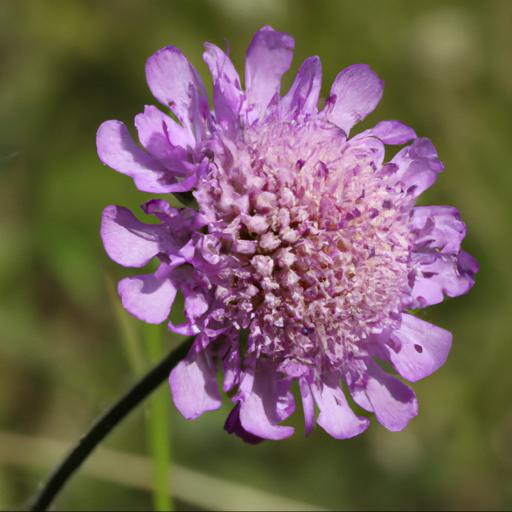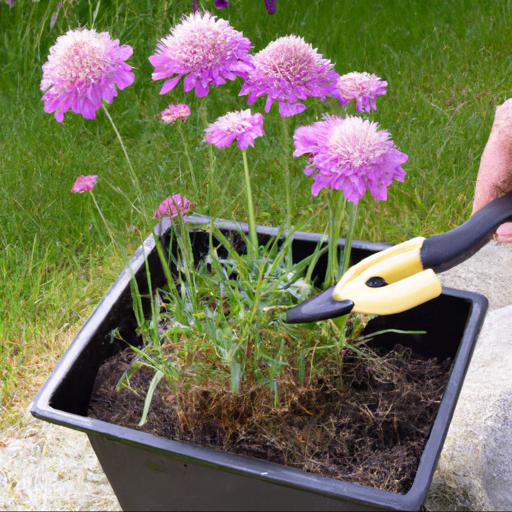Knautia macedonica, also known as Macedonian Scabious, is a stunning perennial flower that is native to the Balkans. It is a popular garden flower, with its vibrant, deep purple petals and its long flowering season.
It is a hardy plant that is relatively easy to grow and maintain, and it is a great addition to any garden. It is a great choice for both beginner and experienced gardeners, as it is low-maintenance and easy to care for. Knautia macedonica is drought tolerant and can tolerate a wide range of soil types, making it a great choice for any garden.
Growing knautia macedonica in the garden

Gardening enthusiasts often search for fun, beautiful and special plants to add to their gardens. One such flower is Knautia macedonica, also commonly known as Red Ball or Gypsy Rose.
Native to Mediterranean regions, Knautia macedonica is a member of the caprifoliaceae family and produces striking, deep maroon blooms during summer months. These flowers, which grow to a height of up to two feet, provide an elegant, romantic look to a garden. Growing Knautia macedonica is relatively easy.
Its hardy nature allows it to withstand light frost conditions, making it a great choice for cooler northern climates. It requires well-drained soil and a sunny location in order to thrive. This plant is often planted in clusters or as an edging plant, ensuring a bright and cheerful display of color.
Accenting a garden with Knautia macedonica can have stunning results. Its deep red flowers have captivated gardeners for centuries and the low-maintenance nature of the plant makes it ideal for anyone who wants to take pleasure in a beautiful garden.
Planting this flower in rock gardens or along pathways helps create a romantic atmosphere. Additionally, its vivid red blooms inspire birds and butterflies to take flight and come to visit, allowing gardeners to enjoy a diverse selection of wildlife in their own backyard.
In conclusion, Knautia macedonica is a beautiful and easy to care for flower that is sure to add a touch of romance and beauty to any garden. With its unique color, these plants are sure to provide your outdoor space with a stunning display of blooms that are sure to bring joy all throughout the summer months.
Benefits of knautia macedonica

A garden filled with a bouquet of stunning Knautia macedonica (Knautia) is sure to attract many admirers. This members of the Caprifoliaceae family, also known as the ‘Macedonian scabious’, was first found in Macedonia and has since spread across much of Europe, Asia, and North Africa. Knautia is a hardy perennial that thrives in a variety of soil conditions and doesn’t require a great deal of maintenance.
It can tolerate some light shade, but will bloom best when grown in full sun. Knautia adds a splash of color to any garden.
It has long-blossoming, fully double flowers that appear in shades of deep mauve, pink and even almost white. The flowers have a distinct star-shape and spread deep up to
5 inches to a diameter of up to 75 inches. The blooming period is a long one, lasting from late spring to late autumn.
Aside from the aesthetically pleasing appearance of Knautia, this plant can also provide a great number of benefits to the garden. It attracts birds and butterflies, which helps create a more vibrant ecosystem.
It is also heat tolerant, grows well in drought-like conditions, and can act as an excellent ground cover and bank cover plant, so it can help control soil erosion and make for a low-maintenance garden without sacrificing beauty. Overall, Knautia macedonica is an excellent addition to any garden, supplying vibrant color and a number of benefits. With its stunning star-shaped blossoms and long blooming period, there’s no doubt that this striking flower will be a beautiful addition to any landscape.
How to care for knautia macedonica

When it comes to Knautia macedonica, otherwise known as the Macedonian Scabiosa, there are several steps gardeners should follow for proper care and maintenance. This plant thrives in full sun, so placing it in a sunny part of your garden or on a patio or balcony that gets plenty of sun can make all the difference. If you live in an area with long, hot summers, providing some afternoon shade may be necessary during the hottest months.
You can easily identify the Macedonian Scabiosa by its tall, erect stems and star-shaped flowers in vibrant shades of purple, pink, and white. For optimal growth, it’s best to water your Macedonian Scabiosa regularly and deeply in order to keep the soil consistently moist.
But be careful not to overwater, as that can cause the plants to produce fewer flowers and be more prone to disease. Your soil should also be nutrient-rich and well-draining for the healthiest plants.
Since Knautia macedonica is a heavy feeder, you should fertilize your plants regularly in spring and summer with a granular fertilizer, or use compost and manure. Deadheading spent flowers will also keep your knautia macedonica looking its best. To deadhead, simply snip the spent flowers off at the base of the stem right after they have bloomed.
This will prevent the plant from wasting energy on producing seeds and encourage more blooms to form. Pinching back tall stems can also help keep the plant from becoming lanky and unattractive. Knautia macedonica can become tall and leggy when allowed to grow unchecked, so regular pruning can help keep it neatly shaped and attractive.
With a bit of care and attention, you’ll soon be rewarded with masses of beautiful blooms that will add both color and texture to your garden.
Common pests and diseases of knautia macedonica
. Knautia macedonica, also known as a chamomile scabious or Balkan scabious, is a popular ornamental flower in UK gardens. It is a perennial plant with deep purple flowers that typically grow about 60 cm tall.
While the flowers offer a burst of vibrant color in the garden, they can be susceptible to a few common pests and diseases. This article will offer an overview of the pests and diseases that knautia macedonica commonly experiences as well as advice on how to best manage them.
The most common pests to affect knautia macedonica are slugs and snails. Slugs and snails feed on the leaves and flowers of the plant resulting in damage. Slugs and snails can be controlled by regularly checking the plant for their presence and hand-picking or trapping them if found.
There are also a variety of chemical control options available including pellets and liquid solutions that are used to target the pests. A second pest commonly seen on knautia macedonica is sap-sucking insects.
These include aphids, whiteflies, and scale insects. These pests feed on the sap within the plant, which can result in weakened plants and distorted leaves of knautia macedonica. The best way to control sap-sucking pests is through prevention by inspecting the plant for signs of insects before planting.
If found, prune off any infected parts of the plants. Additionally, insecticides have proven effective against sap-sucking insects.
The most common disease seen on knautia macedonica is powdery mildew. This fungal disease is recognizable by the whitish-gray Infected infected leaves patches it leaves on the foliage. To prevent this disease, ensure that your plant is in a well-ventilated spot and water them in the morning so the leaves have time to dry out during the day. If powdery mildew appears, treat it with a fungicide immediately. In conclusion, knautia macedonica is one of the most eye-catching perennials in UK gardens. However, it can be affected by a few common pests and diseases. By keeping an eye out for slugs and snails, sap-sucking insects, and powdery mildew, it can be managed and kept healthy and vibrant in the garden.
Our video recommendation
Final Touch
Knautia macedonica is a species of flowering plant native to the Balkans. It is known for its bright pink-purple flowers and attractive foliage.
It is a popular garden plant and can be used as a ground cover or in borders. It is easy to grow and requires little care, making it a great choice for beginner gardeners. It is also a great choice for attracting pollinators to the garden.
FAQ
What is the scientific name of Knautia macedonica?
The scientific name of Knautia macedonica is Knautia macedonica.
Where is Knautia macedonica native to?
Knautia macedonica is native to southeastern Europe, including Bulgaria, Greece, and the Balkan states.
What are the common names for Knautia macedonica?
The common names for Knautia macedonica are Macedonian Scabious, Red Scabious, and Red Knautia.
What are the characteristics of Knautia macedonica?
Knautia macedonica is a perennial flowering plant with bright purple-red flowers and dark green foliage. It is a low-maintenance plant that is easy to grow and is drought tolerant. It is a long-blooming plant that flowers from late spring to early summer and is attractive to bees and butterflies. It is a hardy plant that can tolerate a wide range of temperatures and soil conditions.
How is Knautia macedonica used in gardening?
Knautia macedonica is used in gardening as a flowering perennial plant. It produces attractive, deep-purple flowers that bloom from mid-summer to early fall. It is often used as a border or edging plant, and its long-lasting blooms make it a popular choice for cut flower arrangements.
What are the benefits of planting Knautia macedonica?
The benefits of planting Knautia macedonica include its attractive, long-lasting flowers, its ability to attract pollinators, its drought tolerance, and its low maintenance requirements.

